QMusic Marketing and Management
VerifiedAdded on 2021/06/16
|19
|3649
|105
AI Summary
Contribute Materials
Your contribution can guide someone’s learning journey. Share your
documents today.
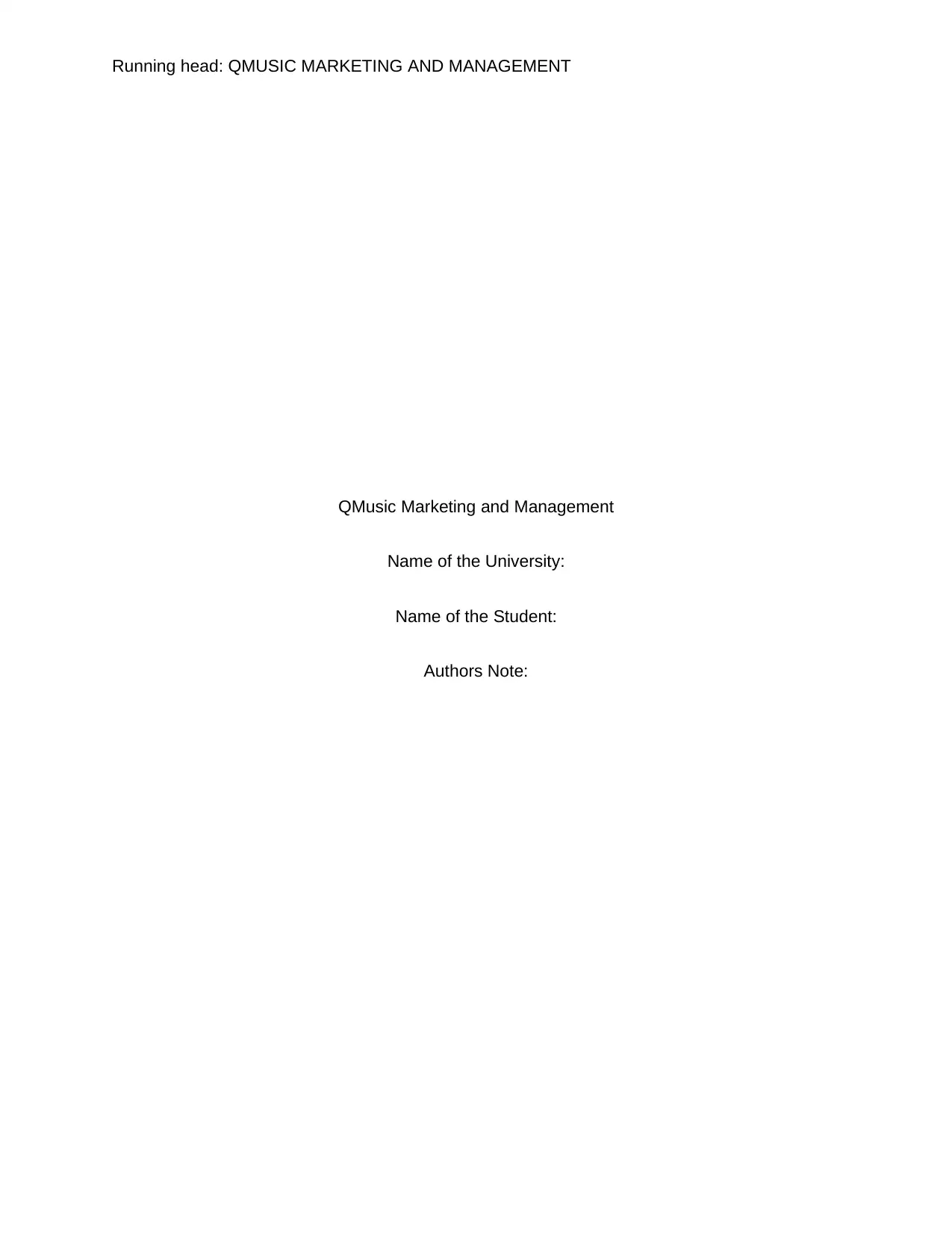
Running head: QMUSIC MARKETING AND MANAGEMENT
QMusic Marketing and Management
Name of the University:
Name of the Student:
Authors Note:
QMusic Marketing and Management
Name of the University:
Name of the Student:
Authors Note:
Secure Best Marks with AI Grader
Need help grading? Try our AI Grader for instant feedback on your assignments.
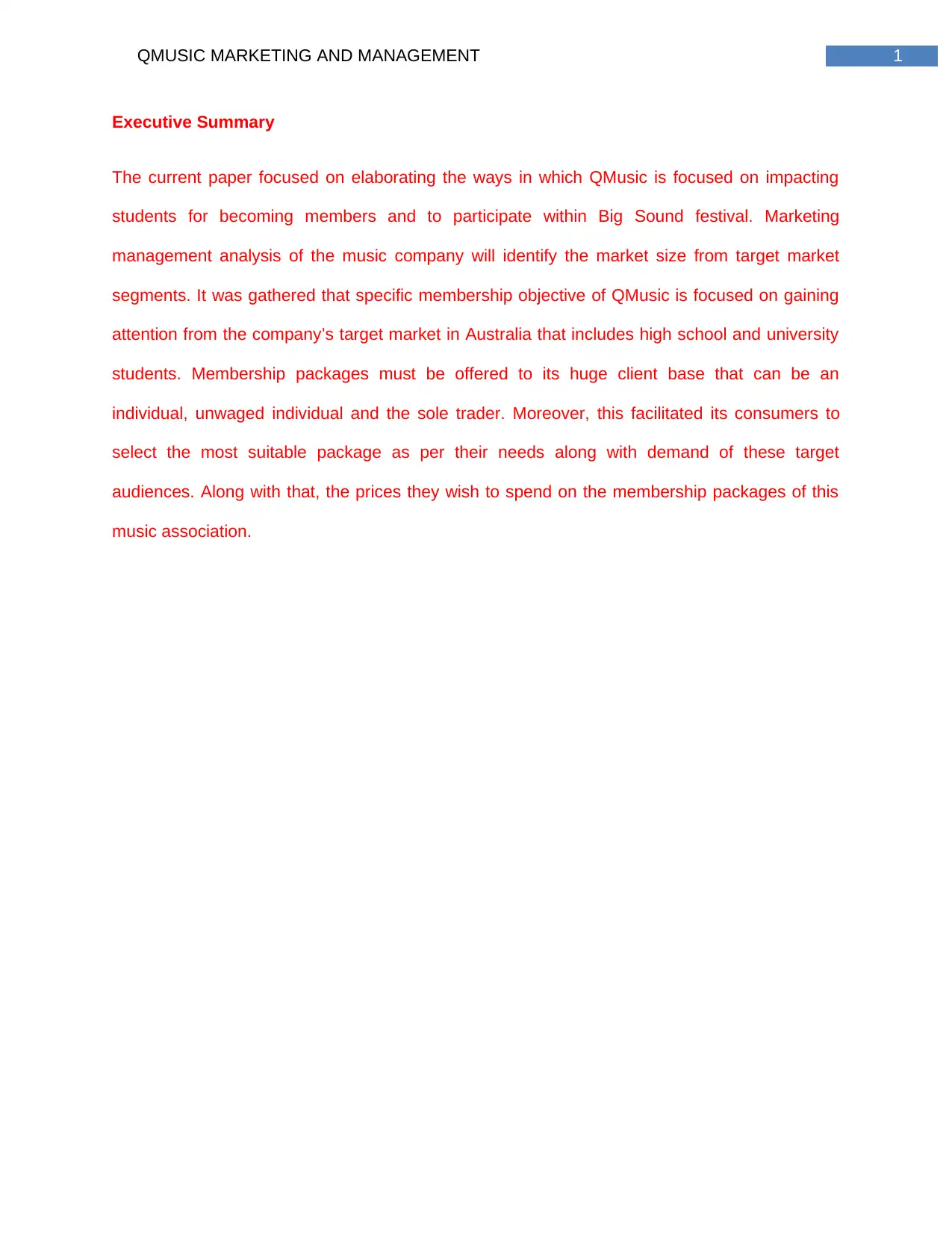
1QMUSIC MARKETING AND MANAGEMENT
Executive Summary
The current paper focused on elaborating the ways in which QMusic is focused on impacting
students for becoming members and to participate within Big Sound festival. Marketing
management analysis of the music company will identify the market size from target market
segments. It was gathered that specific membership objective of QMusic is focused on gaining
attention from the company’s target market in Australia that includes high school and university
students. Membership packages must be offered to its huge client base that can be an
individual, unwaged individual and the sole trader. Moreover, this facilitated its consumers to
select the most suitable package as per their needs along with demand of these target
audiences. Along with that, the prices they wish to spend on the membership packages of this
music association.
Executive Summary
The current paper focused on elaborating the ways in which QMusic is focused on impacting
students for becoming members and to participate within Big Sound festival. Marketing
management analysis of the music company will identify the market size from target market
segments. It was gathered that specific membership objective of QMusic is focused on gaining
attention from the company’s target market in Australia that includes high school and university
students. Membership packages must be offered to its huge client base that can be an
individual, unwaged individual and the sole trader. Moreover, this facilitated its consumers to
select the most suitable package as per their needs along with demand of these target
audiences. Along with that, the prices they wish to spend on the membership packages of this
music association.
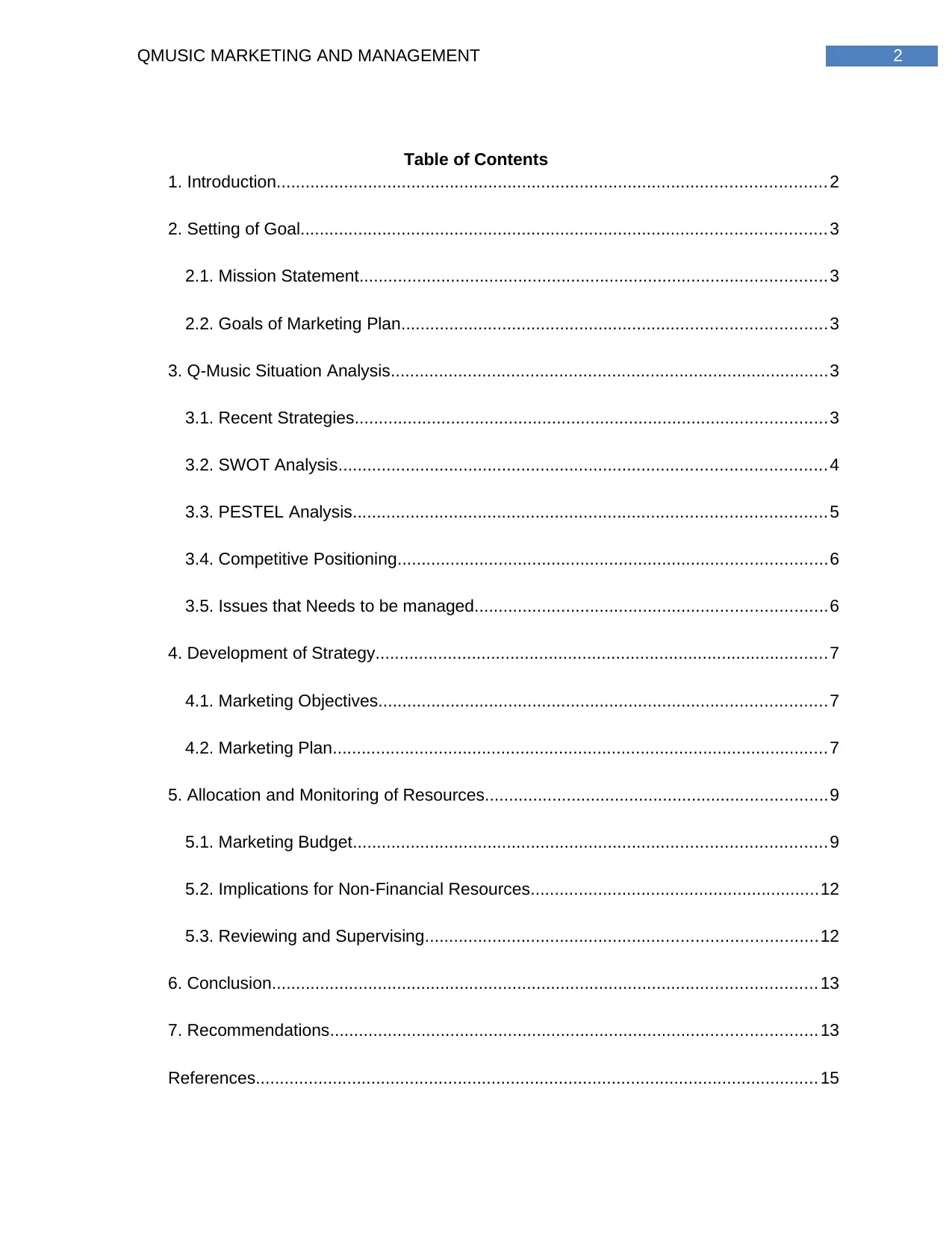
2QMUSIC MARKETING AND MANAGEMENT
Table of Contents
1. Introduction.................................................................................................................. 2
2. Setting of Goal............................................................................................................. 3
2.1. Mission Statement.................................................................................................3
2.2. Goals of Marketing Plan........................................................................................3
3. Q-Music Situation Analysis...........................................................................................3
3.1. Recent Strategies..................................................................................................3
3.2. SWOT Analysis.....................................................................................................4
3.3. PESTEL Analysis..................................................................................................5
3.4. Competitive Positioning.........................................................................................6
3.5. Issues that Needs to be managed.........................................................................6
4. Development of Strategy..............................................................................................7
4.1. Marketing Objectives.............................................................................................7
4.2. Marketing Plan.......................................................................................................7
5. Allocation and Monitoring of Resources.......................................................................9
5.1. Marketing Budget..................................................................................................9
5.2. Implications for Non-Financial Resources............................................................12
5.3. Reviewing and Supervising.................................................................................12
6. Conclusion................................................................................................................. 13
7. Recommendations.....................................................................................................13
References..................................................................................................................... 15
Table of Contents
1. Introduction.................................................................................................................. 2
2. Setting of Goal............................................................................................................. 3
2.1. Mission Statement.................................................................................................3
2.2. Goals of Marketing Plan........................................................................................3
3. Q-Music Situation Analysis...........................................................................................3
3.1. Recent Strategies..................................................................................................3
3.2. SWOT Analysis.....................................................................................................4
3.3. PESTEL Analysis..................................................................................................5
3.4. Competitive Positioning.........................................................................................6
3.5. Issues that Needs to be managed.........................................................................6
4. Development of Strategy..............................................................................................7
4.1. Marketing Objectives.............................................................................................7
4.2. Marketing Plan.......................................................................................................7
5. Allocation and Monitoring of Resources.......................................................................9
5.1. Marketing Budget..................................................................................................9
5.2. Implications for Non-Financial Resources............................................................12
5.3. Reviewing and Supervising.................................................................................12
6. Conclusion................................................................................................................. 13
7. Recommendations.....................................................................................................13
References..................................................................................................................... 15
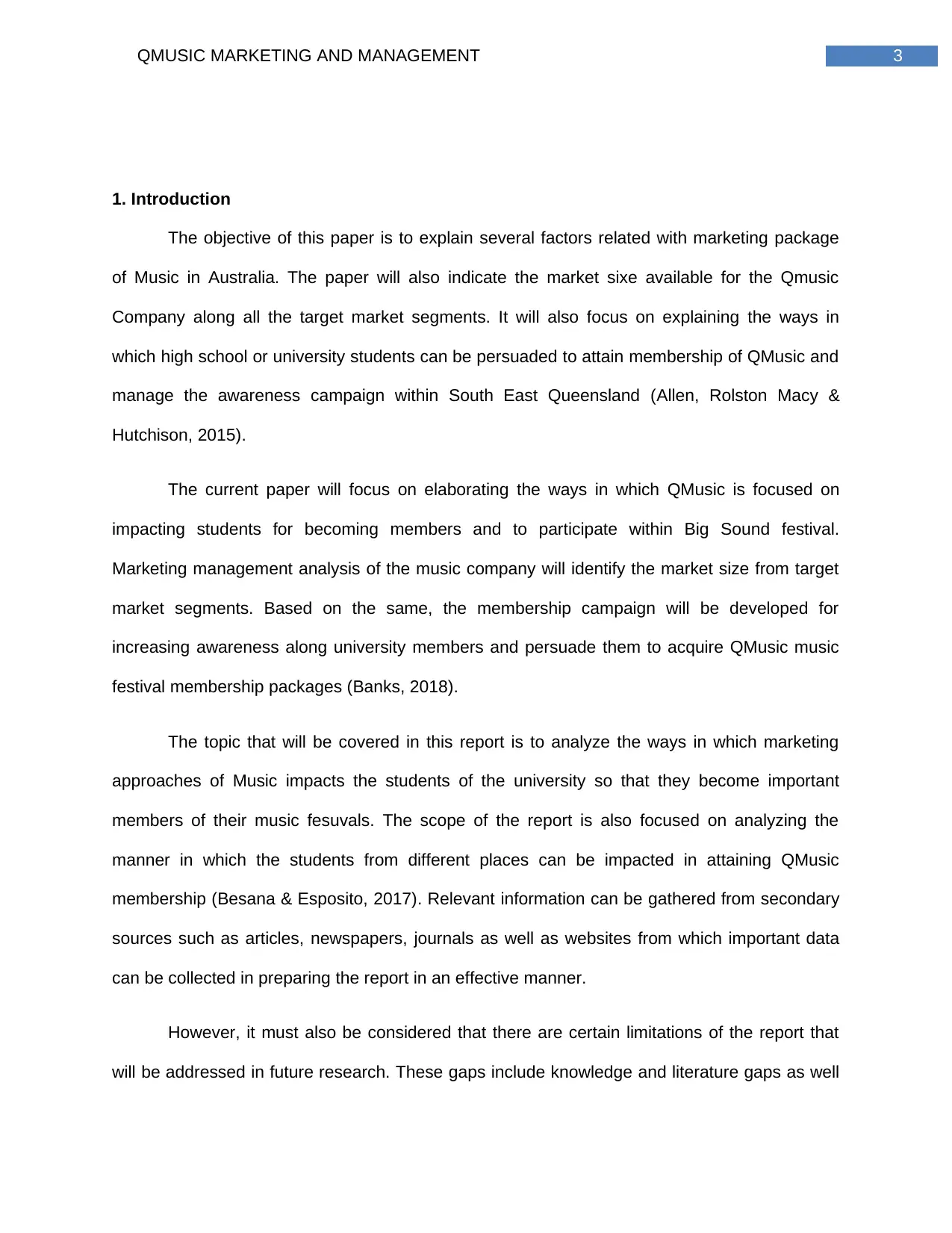
3QMUSIC MARKETING AND MANAGEMENT
1. Introduction
The objective of this paper is to explain several factors related with marketing package
of Music in Australia. The paper will also indicate the market sixe available for the Qmusic
Company along all the target market segments. It will also focus on explaining the ways in
which high school or university students can be persuaded to attain membership of QMusic and
manage the awareness campaign within South East Queensland (Allen, Rolston Macy &
Hutchison, 2015).
The current paper will focus on elaborating the ways in which QMusic is focused on
impacting students for becoming members and to participate within Big Sound festival.
Marketing management analysis of the music company will identify the market size from target
market segments. Based on the same, the membership campaign will be developed for
increasing awareness along university members and persuade them to acquire QMusic music
festival membership packages (Banks, 2018).
The topic that will be covered in this report is to analyze the ways in which marketing
approaches of Music impacts the students of the university so that they become important
members of their music fesuvals. The scope of the report is also focused on analyzing the
manner in which the students from different places can be impacted in attaining QMusic
membership (Besana & Esposito, 2017). Relevant information can be gathered from secondary
sources such as articles, newspapers, journals as well as websites from which important data
can be collected in preparing the report in an effective manner.
However, it must also be considered that there are certain limitations of the report that
will be addressed in future research. These gaps include knowledge and literature gaps as well
1. Introduction
The objective of this paper is to explain several factors related with marketing package
of Music in Australia. The paper will also indicate the market sixe available for the Qmusic
Company along all the target market segments. It will also focus on explaining the ways in
which high school or university students can be persuaded to attain membership of QMusic and
manage the awareness campaign within South East Queensland (Allen, Rolston Macy &
Hutchison, 2015).
The current paper will focus on elaborating the ways in which QMusic is focused on
impacting students for becoming members and to participate within Big Sound festival.
Marketing management analysis of the music company will identify the market size from target
market segments. Based on the same, the membership campaign will be developed for
increasing awareness along university members and persuade them to acquire QMusic music
festival membership packages (Banks, 2018).
The topic that will be covered in this report is to analyze the ways in which marketing
approaches of Music impacts the students of the university so that they become important
members of their music fesuvals. The scope of the report is also focused on analyzing the
manner in which the students from different places can be impacted in attaining QMusic
membership (Besana & Esposito, 2017). Relevant information can be gathered from secondary
sources such as articles, newspapers, journals as well as websites from which important data
can be collected in preparing the report in an effective manner.
However, it must also be considered that there are certain limitations of the report that
will be addressed in future research. These gaps include knowledge and literature gaps as well
Secure Best Marks with AI Grader
Need help grading? Try our AI Grader for instant feedback on your assignments.
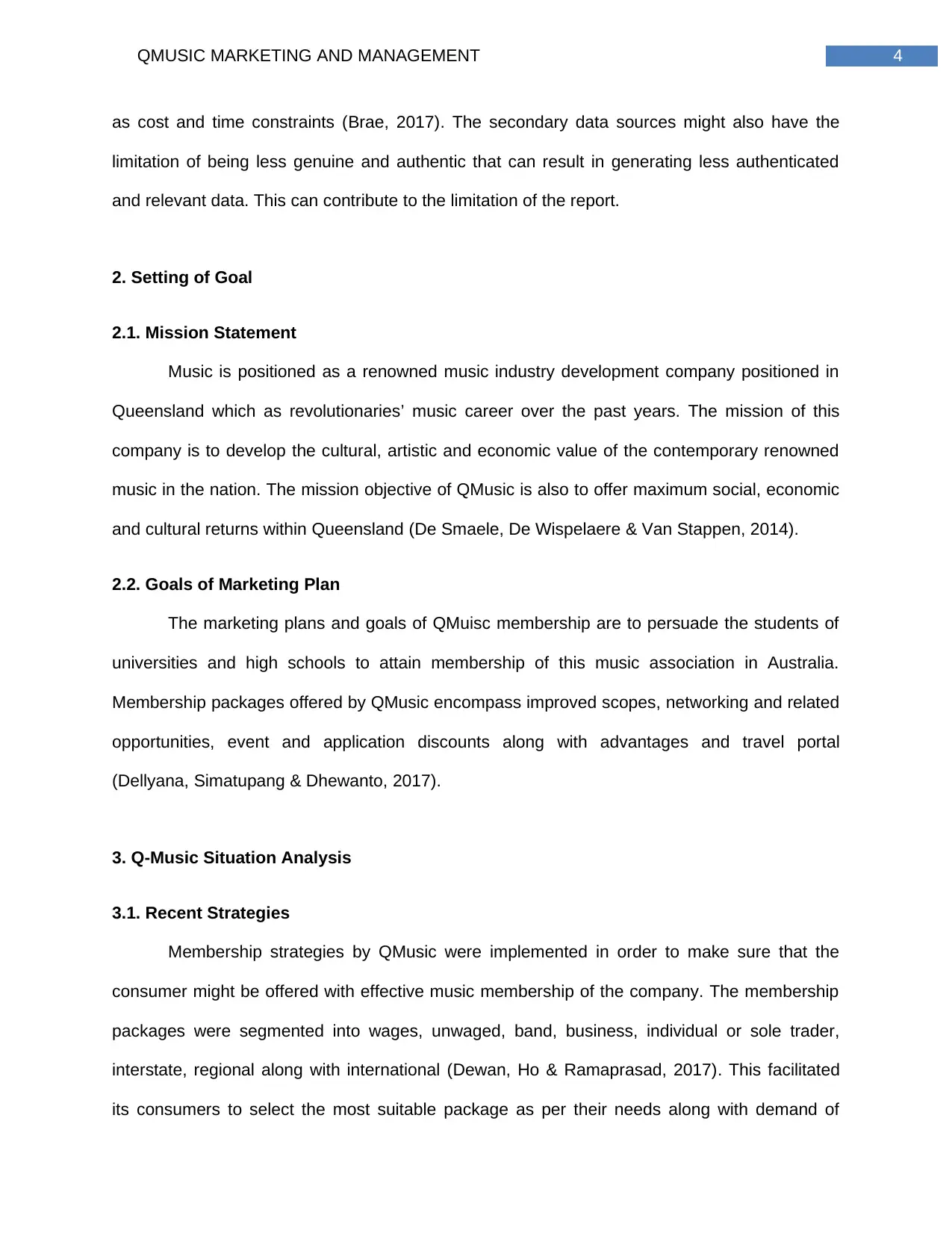
4QMUSIC MARKETING AND MANAGEMENT
as cost and time constraints (Brae, 2017). The secondary data sources might also have the
limitation of being less genuine and authentic that can result in generating less authenticated
and relevant data. This can contribute to the limitation of the report.
2. Setting of Goal
2.1. Mission Statement
Music is positioned as a renowned music industry development company positioned in
Queensland which as revolutionaries’ music career over the past years. The mission of this
company is to develop the cultural, artistic and economic value of the contemporary renowned
music in the nation. The mission objective of QMusic is also to offer maximum social, economic
and cultural returns within Queensland (De Smaele, De Wispelaere & Van Stappen, 2014).
2.2. Goals of Marketing Plan
The marketing plans and goals of QMuisc membership are to persuade the students of
universities and high schools to attain membership of this music association in Australia.
Membership packages offered by QMusic encompass improved scopes, networking and related
opportunities, event and application discounts along with advantages and travel portal
(Dellyana, Simatupang & Dhewanto, 2017).
3. Q-Music Situation Analysis
3.1. Recent Strategies
Membership strategies by QMusic were implemented in order to make sure that the
consumer might be offered with effective music membership of the company. The membership
packages were segmented into wages, unwaged, band, business, individual or sole trader,
interstate, regional along with international (Dewan, Ho & Ramaprasad, 2017). This facilitated
its consumers to select the most suitable package as per their needs along with demand of
as cost and time constraints (Brae, 2017). The secondary data sources might also have the
limitation of being less genuine and authentic that can result in generating less authenticated
and relevant data. This can contribute to the limitation of the report.
2. Setting of Goal
2.1. Mission Statement
Music is positioned as a renowned music industry development company positioned in
Queensland which as revolutionaries’ music career over the past years. The mission of this
company is to develop the cultural, artistic and economic value of the contemporary renowned
music in the nation. The mission objective of QMusic is also to offer maximum social, economic
and cultural returns within Queensland (De Smaele, De Wispelaere & Van Stappen, 2014).
2.2. Goals of Marketing Plan
The marketing plans and goals of QMuisc membership are to persuade the students of
universities and high schools to attain membership of this music association in Australia.
Membership packages offered by QMusic encompass improved scopes, networking and related
opportunities, event and application discounts along with advantages and travel portal
(Dellyana, Simatupang & Dhewanto, 2017).
3. Q-Music Situation Analysis
3.1. Recent Strategies
Membership strategies by QMusic were implemented in order to make sure that the
consumer might be offered with effective music membership of the company. The membership
packages were segmented into wages, unwaged, band, business, individual or sole trader,
interstate, regional along with international (Dewan, Ho & Ramaprasad, 2017). This facilitated
its consumers to select the most suitable package as per their needs along with demand of
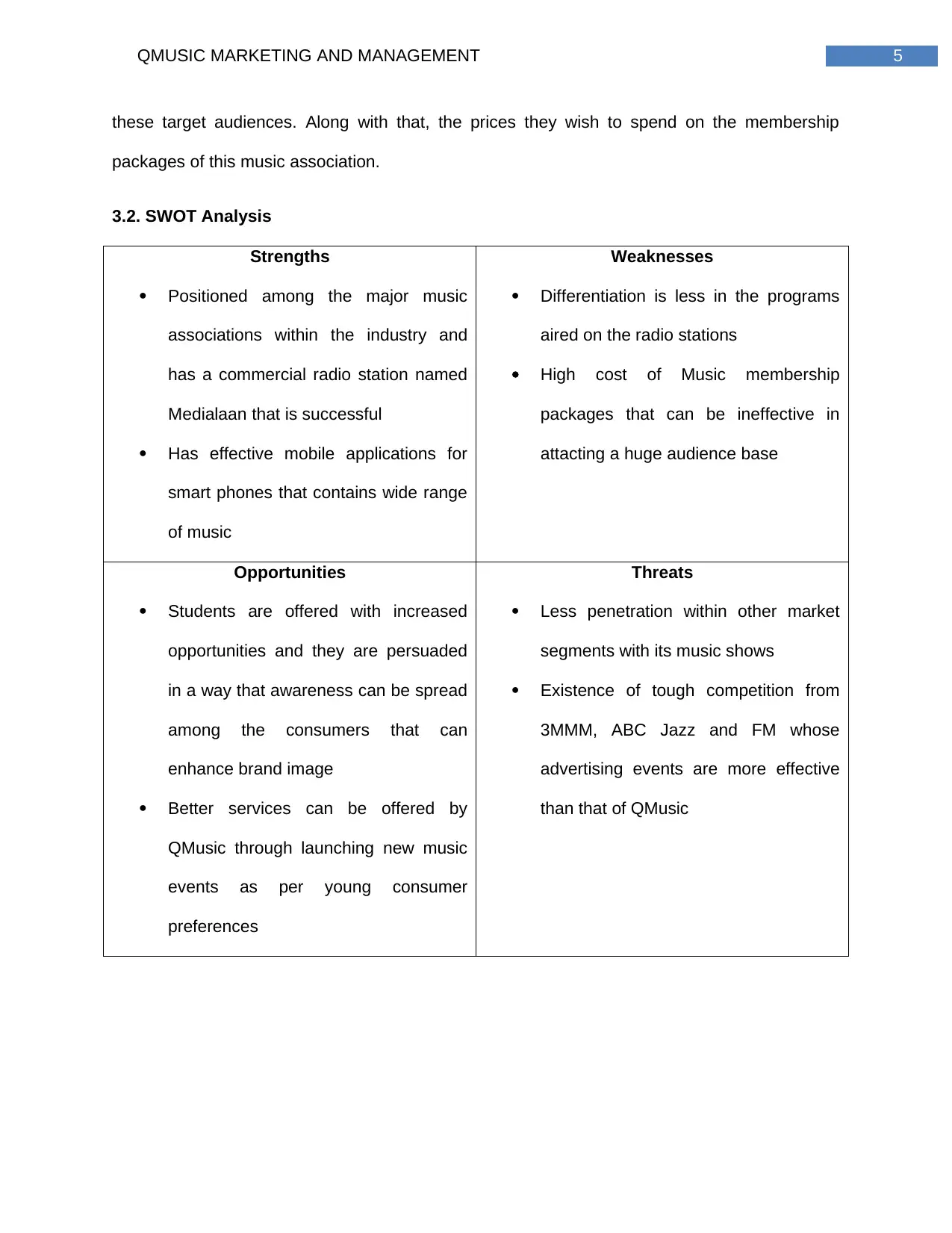
5QMUSIC MARKETING AND MANAGEMENT
these target audiences. Along with that, the prices they wish to spend on the membership
packages of this music association.
3.2. SWOT Analysis
Strengths
Positioned among the major music
associations within the industry and
has a commercial radio station named
Medialaan that is successful
Has effective mobile applications for
smart phones that contains wide range
of music
Weaknesses
Differentiation is less in the programs
aired on the radio stations
High cost of Music membership
packages that can be ineffective in
attacting a huge audience base
Opportunities
Students are offered with increased
opportunities and they are persuaded
in a way that awareness can be spread
among the consumers that can
enhance brand image
Better services can be offered by
QMusic through launching new music
events as per young consumer
preferences
Threats
Less penetration within other market
segments with its music shows
Existence of tough competition from
3MMM, ABC Jazz and FM whose
advertising events are more effective
than that of QMusic
these target audiences. Along with that, the prices they wish to spend on the membership
packages of this music association.
3.2. SWOT Analysis
Strengths
Positioned among the major music
associations within the industry and
has a commercial radio station named
Medialaan that is successful
Has effective mobile applications for
smart phones that contains wide range
of music
Weaknesses
Differentiation is less in the programs
aired on the radio stations
High cost of Music membership
packages that can be ineffective in
attacting a huge audience base
Opportunities
Students are offered with increased
opportunities and they are persuaded
in a way that awareness can be spread
among the consumers that can
enhance brand image
Better services can be offered by
QMusic through launching new music
events as per young consumer
preferences
Threats
Less penetration within other market
segments with its music shows
Existence of tough competition from
3MMM, ABC Jazz and FM whose
advertising events are more effective
than that of QMusic
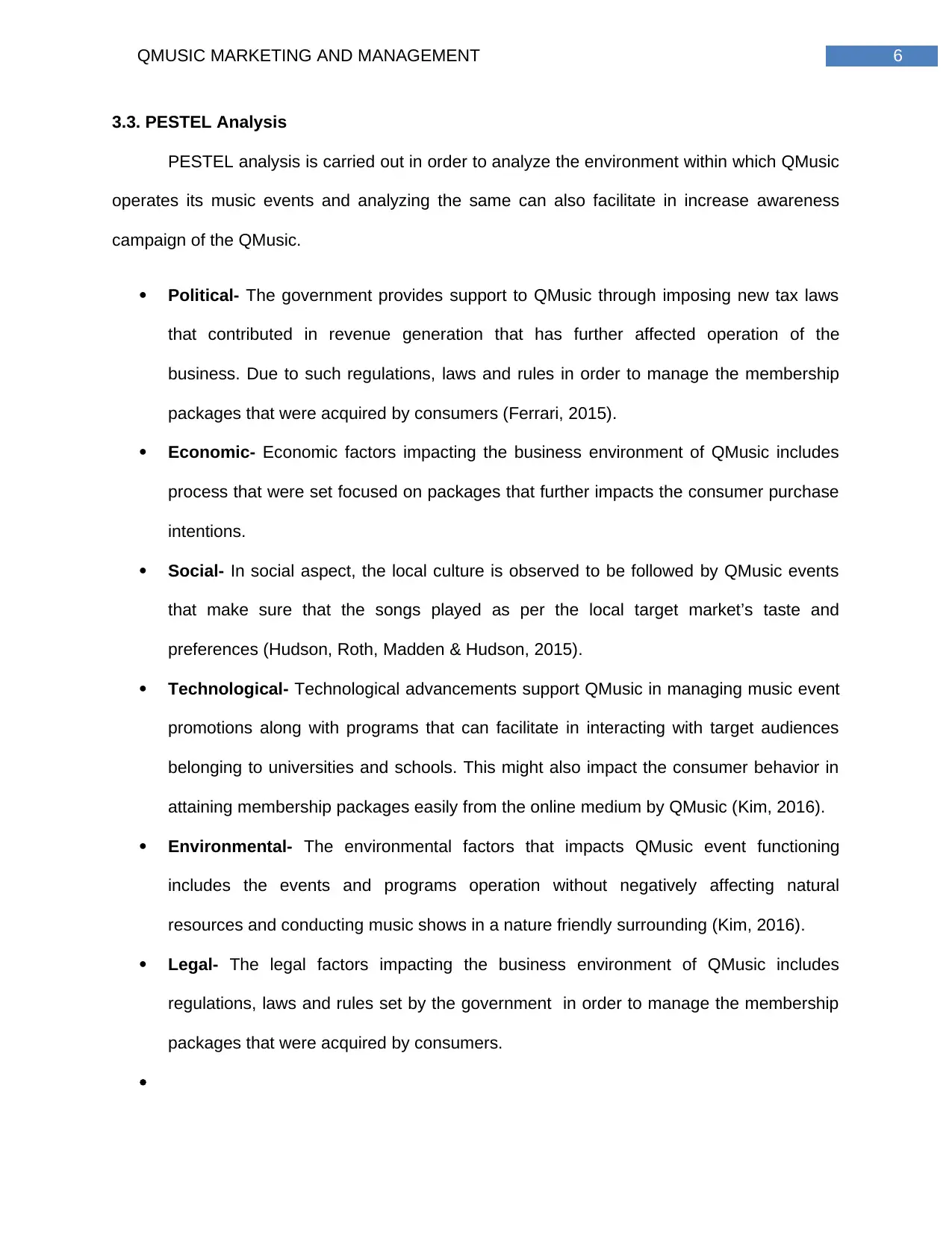
6QMUSIC MARKETING AND MANAGEMENT
3.3. PESTEL Analysis
PESTEL analysis is carried out in order to analyze the environment within which QMusic
operates its music events and analyzing the same can also facilitate in increase awareness
campaign of the QMusic.
Political- The government provides support to QMusic through imposing new tax laws
that contributed in revenue generation that has further affected operation of the
business. Due to such regulations, laws and rules in order to manage the membership
packages that were acquired by consumers (Ferrari, 2015).
Economic- Economic factors impacting the business environment of QMusic includes
process that were set focused on packages that further impacts the consumer purchase
intentions.
Social- In social aspect, the local culture is observed to be followed by QMusic events
that make sure that the songs played as per the local target market’s taste and
preferences (Hudson, Roth, Madden & Hudson, 2015).
Technological- Technological advancements support QMusic in managing music event
promotions along with programs that can facilitate in interacting with target audiences
belonging to universities and schools. This might also impact the consumer behavior in
attaining membership packages easily from the online medium by QMusic (Kim, 2016).
Environmental- The environmental factors that impacts QMusic event functioning
includes the events and programs operation without negatively affecting natural
resources and conducting music shows in a nature friendly surrounding (Kim, 2016).
Legal- The legal factors impacting the business environment of QMusic includes
regulations, laws and rules set by the government in order to manage the membership
packages that were acquired by consumers.
3.3. PESTEL Analysis
PESTEL analysis is carried out in order to analyze the environment within which QMusic
operates its music events and analyzing the same can also facilitate in increase awareness
campaign of the QMusic.
Political- The government provides support to QMusic through imposing new tax laws
that contributed in revenue generation that has further affected operation of the
business. Due to such regulations, laws and rules in order to manage the membership
packages that were acquired by consumers (Ferrari, 2015).
Economic- Economic factors impacting the business environment of QMusic includes
process that were set focused on packages that further impacts the consumer purchase
intentions.
Social- In social aspect, the local culture is observed to be followed by QMusic events
that make sure that the songs played as per the local target market’s taste and
preferences (Hudson, Roth, Madden & Hudson, 2015).
Technological- Technological advancements support QMusic in managing music event
promotions along with programs that can facilitate in interacting with target audiences
belonging to universities and schools. This might also impact the consumer behavior in
attaining membership packages easily from the online medium by QMusic (Kim, 2016).
Environmental- The environmental factors that impacts QMusic event functioning
includes the events and programs operation without negatively affecting natural
resources and conducting music shows in a nature friendly surrounding (Kim, 2016).
Legal- The legal factors impacting the business environment of QMusic includes
regulations, laws and rules set by the government in order to manage the membership
packages that were acquired by consumers.
Paraphrase This Document
Need a fresh take? Get an instant paraphrase of this document with our AI Paraphraser
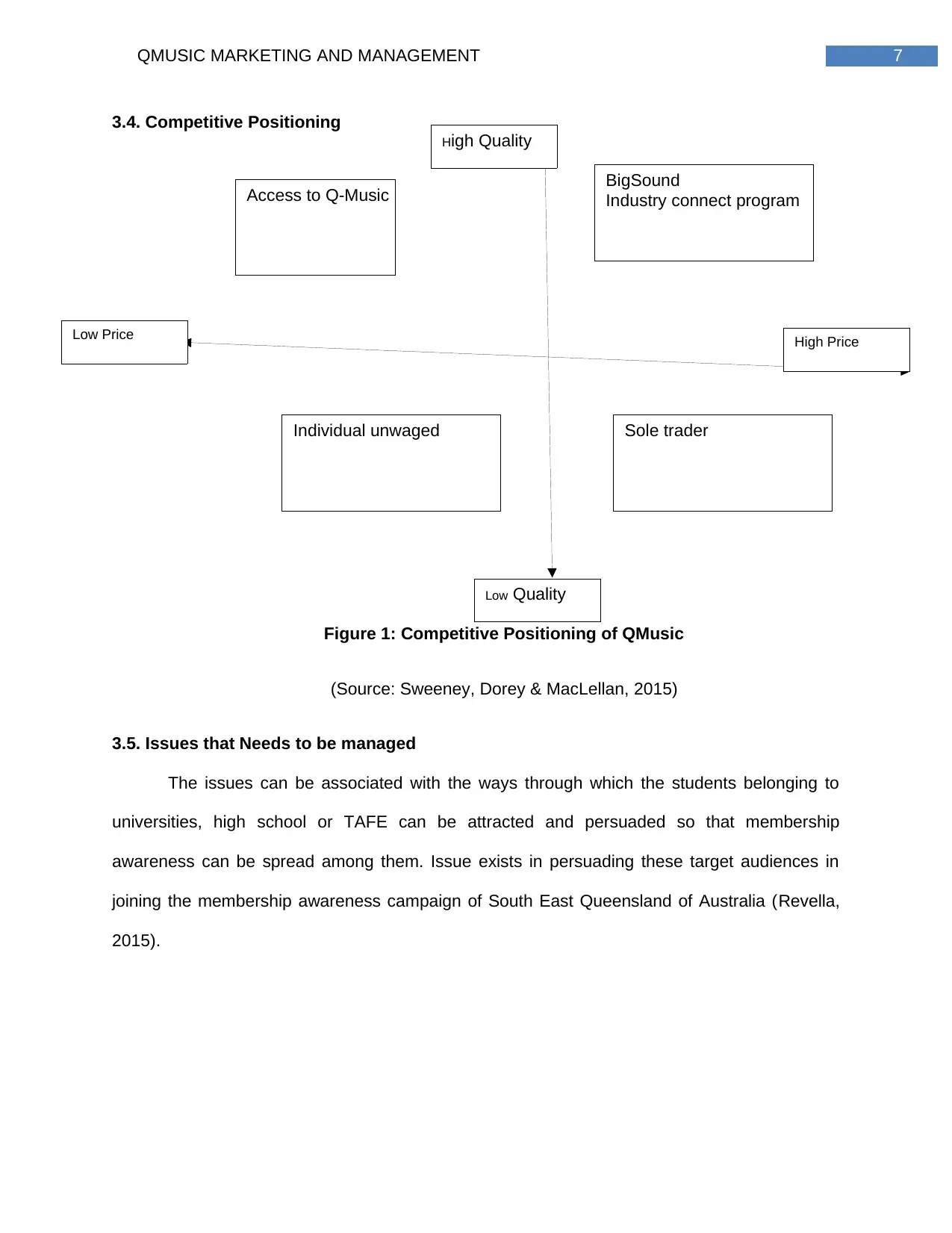
7QMUSIC MARKETING AND MANAGEMENT
Access to Q-Music BigSound
Industry connect program
Sole traderIndividual unwaged
High Price
3.4. Competitive Positioning
Figure 1: Competitive Positioning of QMusic
(Source: Sweeney, Dorey & MacLellan, 2015)
3.5. Issues that Needs to be managed
The issues can be associated with the ways through which the students belonging to
universities, high school or TAFE can be attracted and persuaded so that membership
awareness can be spread among them. Issue exists in persuading these target audiences in
joining the membership awareness campaign of South East Queensland of Australia (Revella,
2015).
High Quality
Low Quality
Low Price
Access to Q-Music BigSound
Industry connect program
Sole traderIndividual unwaged
High Price
3.4. Competitive Positioning
Figure 1: Competitive Positioning of QMusic
(Source: Sweeney, Dorey & MacLellan, 2015)
3.5. Issues that Needs to be managed
The issues can be associated with the ways through which the students belonging to
universities, high school or TAFE can be attracted and persuaded so that membership
awareness can be spread among them. Issue exists in persuading these target audiences in
joining the membership awareness campaign of South East Queensland of Australia (Revella,
2015).
High Quality
Low Quality
Low Price
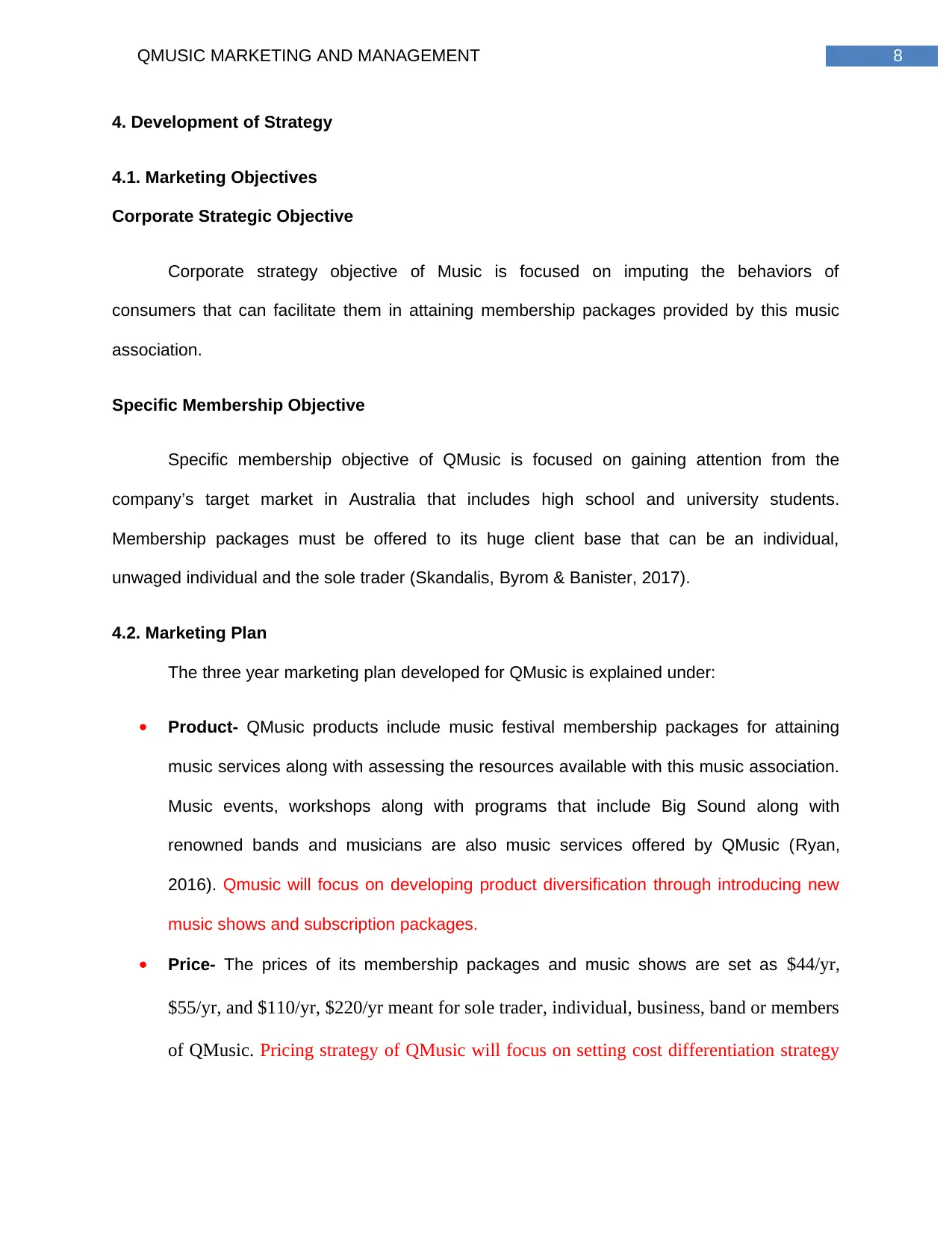
8QMUSIC MARKETING AND MANAGEMENT
4. Development of Strategy
4.1. Marketing Objectives
Corporate Strategic Objective
Corporate strategy objective of Music is focused on imputing the behaviors of
consumers that can facilitate them in attaining membership packages provided by this music
association.
Specific Membership Objective
Specific membership objective of QMusic is focused on gaining attention from the
company’s target market in Australia that includes high school and university students.
Membership packages must be offered to its huge client base that can be an individual,
unwaged individual and the sole trader (Skandalis, Byrom & Banister, 2017).
4.2. Marketing Plan
The three year marketing plan developed for QMusic is explained under:
Product- QMusic products include music festival membership packages for attaining
music services along with assessing the resources available with this music association.
Music events, workshops along with programs that include Big Sound along with
renowned bands and musicians are also music services offered by QMusic (Ryan,
2016). Qmusic will focus on developing product diversification through introducing new
music shows and subscription packages.
Price- The prices of its membership packages and music shows are set as $44/yr,
$55/yr, and $110/yr, $220/yr meant for sole trader, individual, business, band or members
of QMusic. Pricing strategy of QMusic will focus on setting cost differentiation strategy
4. Development of Strategy
4.1. Marketing Objectives
Corporate Strategic Objective
Corporate strategy objective of Music is focused on imputing the behaviors of
consumers that can facilitate them in attaining membership packages provided by this music
association.
Specific Membership Objective
Specific membership objective of QMusic is focused on gaining attention from the
company’s target market in Australia that includes high school and university students.
Membership packages must be offered to its huge client base that can be an individual,
unwaged individual and the sole trader (Skandalis, Byrom & Banister, 2017).
4.2. Marketing Plan
The three year marketing plan developed for QMusic is explained under:
Product- QMusic products include music festival membership packages for attaining
music services along with assessing the resources available with this music association.
Music events, workshops along with programs that include Big Sound along with
renowned bands and musicians are also music services offered by QMusic (Ryan,
2016). Qmusic will focus on developing product diversification through introducing new
music shows and subscription packages.
Price- The prices of its membership packages and music shows are set as $44/yr,
$55/yr, and $110/yr, $220/yr meant for sole trader, individual, business, band or members
of QMusic. Pricing strategy of QMusic will focus on setting cost differentiation strategy
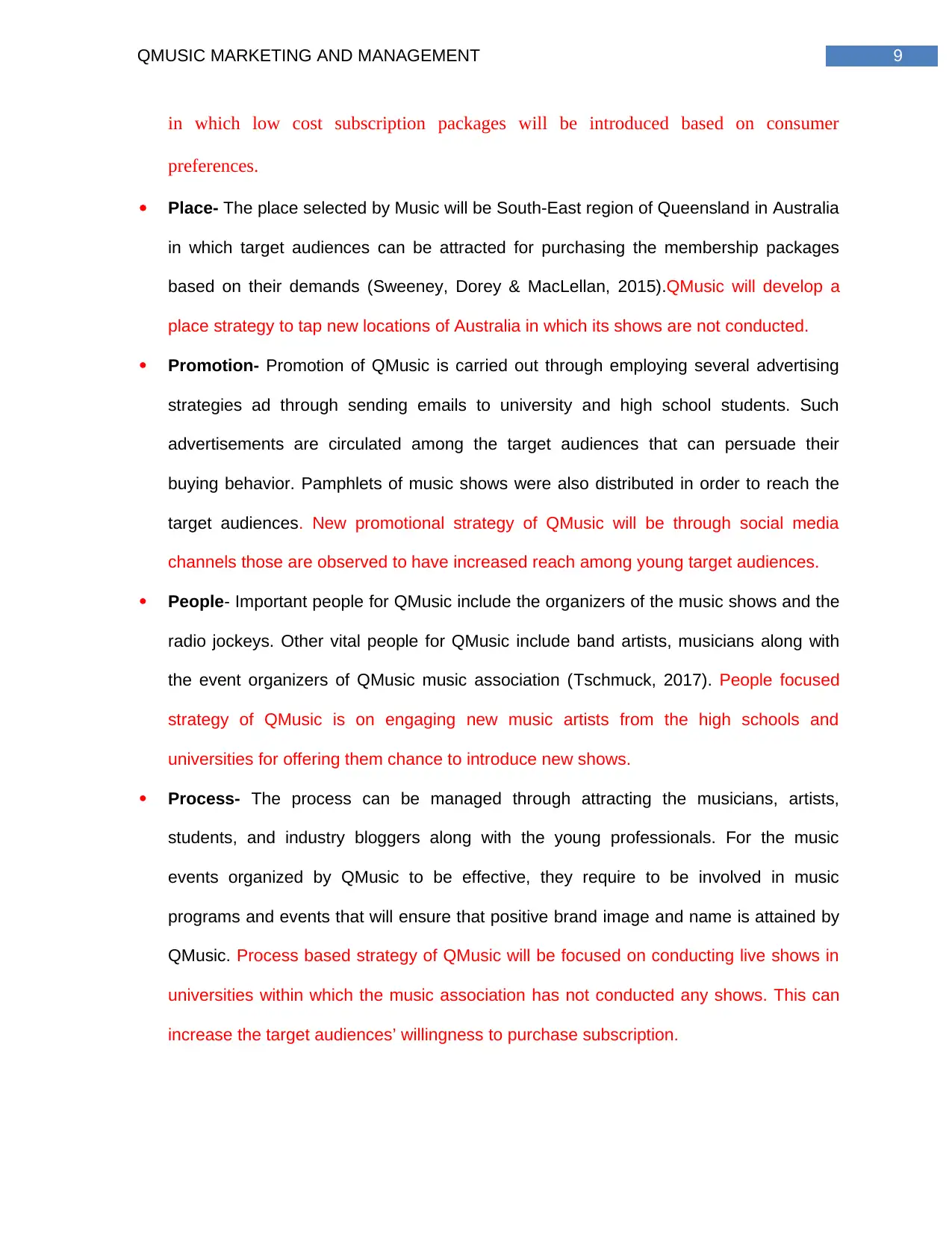
9QMUSIC MARKETING AND MANAGEMENT
in which low cost subscription packages will be introduced based on consumer
preferences.
Place- The place selected by Music will be South-East region of Queensland in Australia
in which target audiences can be attracted for purchasing the membership packages
based on their demands (Sweeney, Dorey & MacLellan, 2015).QMusic will develop a
place strategy to tap new locations of Australia in which its shows are not conducted.
Promotion- Promotion of QMusic is carried out through employing several advertising
strategies ad through sending emails to university and high school students. Such
advertisements are circulated among the target audiences that can persuade their
buying behavior. Pamphlets of music shows were also distributed in order to reach the
target audiences. New promotional strategy of QMusic will be through social media
channels those are observed to have increased reach among young target audiences.
People- Important people for QMusic include the organizers of the music shows and the
radio jockeys. Other vital people for QMusic include band artists, musicians along with
the event organizers of QMusic music association (Tschmuck, 2017). People focused
strategy of QMusic is on engaging new music artists from the high schools and
universities for offering them chance to introduce new shows.
Process- The process can be managed through attracting the musicians, artists,
students, and industry bloggers along with the young professionals. For the music
events organized by QMusic to be effective, they require to be involved in music
programs and events that will ensure that positive brand image and name is attained by
QMusic. Process based strategy of QMusic will be focused on conducting live shows in
universities within which the music association has not conducted any shows. This can
increase the target audiences’ willingness to purchase subscription.
in which low cost subscription packages will be introduced based on consumer
preferences.
Place- The place selected by Music will be South-East region of Queensland in Australia
in which target audiences can be attracted for purchasing the membership packages
based on their demands (Sweeney, Dorey & MacLellan, 2015).QMusic will develop a
place strategy to tap new locations of Australia in which its shows are not conducted.
Promotion- Promotion of QMusic is carried out through employing several advertising
strategies ad through sending emails to university and high school students. Such
advertisements are circulated among the target audiences that can persuade their
buying behavior. Pamphlets of music shows were also distributed in order to reach the
target audiences. New promotional strategy of QMusic will be through social media
channels those are observed to have increased reach among young target audiences.
People- Important people for QMusic include the organizers of the music shows and the
radio jockeys. Other vital people for QMusic include band artists, musicians along with
the event organizers of QMusic music association (Tschmuck, 2017). People focused
strategy of QMusic is on engaging new music artists from the high schools and
universities for offering them chance to introduce new shows.
Process- The process can be managed through attracting the musicians, artists,
students, and industry bloggers along with the young professionals. For the music
events organized by QMusic to be effective, they require to be involved in music
programs and events that will ensure that positive brand image and name is attained by
QMusic. Process based strategy of QMusic will be focused on conducting live shows in
universities within which the music association has not conducted any shows. This can
increase the target audiences’ willingness to purchase subscription.
Secure Best Marks with AI Grader
Need help grading? Try our AI Grader for instant feedback on your assignments.
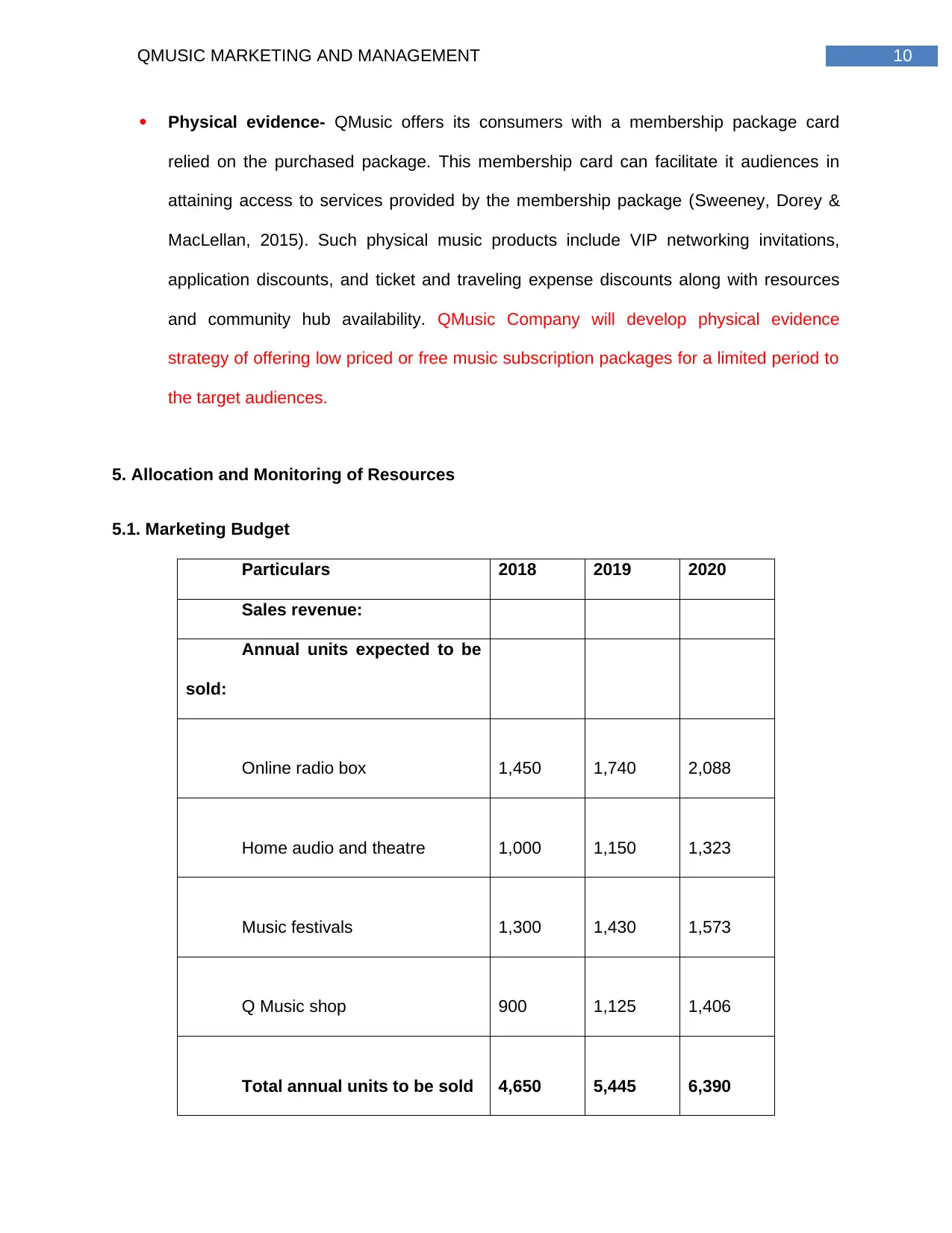
10QMUSIC MARKETING AND MANAGEMENT
Physical evidence- QMusic offers its consumers with a membership package card
relied on the purchased package. This membership card can facilitate it audiences in
attaining access to services provided by the membership package (Sweeney, Dorey &
MacLellan, 2015). Such physical music products include VIP networking invitations,
application discounts, and ticket and traveling expense discounts along with resources
and community hub availability. QMusic Company will develop physical evidence
strategy of offering low priced or free music subscription packages for a limited period to
the target audiences.
5. Allocation and Monitoring of Resources
5.1. Marketing Budget
Particulars 2018 2019 2020
Sales revenue:
Annual units expected to be
sold:
Online radio box 1,450 1,740 2,088
Home audio and theatre 1,000 1,150 1,323
Music festivals 1,300 1,430 1,573
Q Music shop 900 1,125 1,406
Total annual units to be sold 4,650 5,445 6,390
Physical evidence- QMusic offers its consumers with a membership package card
relied on the purchased package. This membership card can facilitate it audiences in
attaining access to services provided by the membership package (Sweeney, Dorey &
MacLellan, 2015). Such physical music products include VIP networking invitations,
application discounts, and ticket and traveling expense discounts along with resources
and community hub availability. QMusic Company will develop physical evidence
strategy of offering low priced or free music subscription packages for a limited period to
the target audiences.
5. Allocation and Monitoring of Resources
5.1. Marketing Budget
Particulars 2018 2019 2020
Sales revenue:
Annual units expected to be
sold:
Online radio box 1,450 1,740 2,088
Home audio and theatre 1,000 1,150 1,323
Music festivals 1,300 1,430 1,573
Q Music shop 900 1,125 1,406
Total annual units to be sold 4,650 5,445 6,390
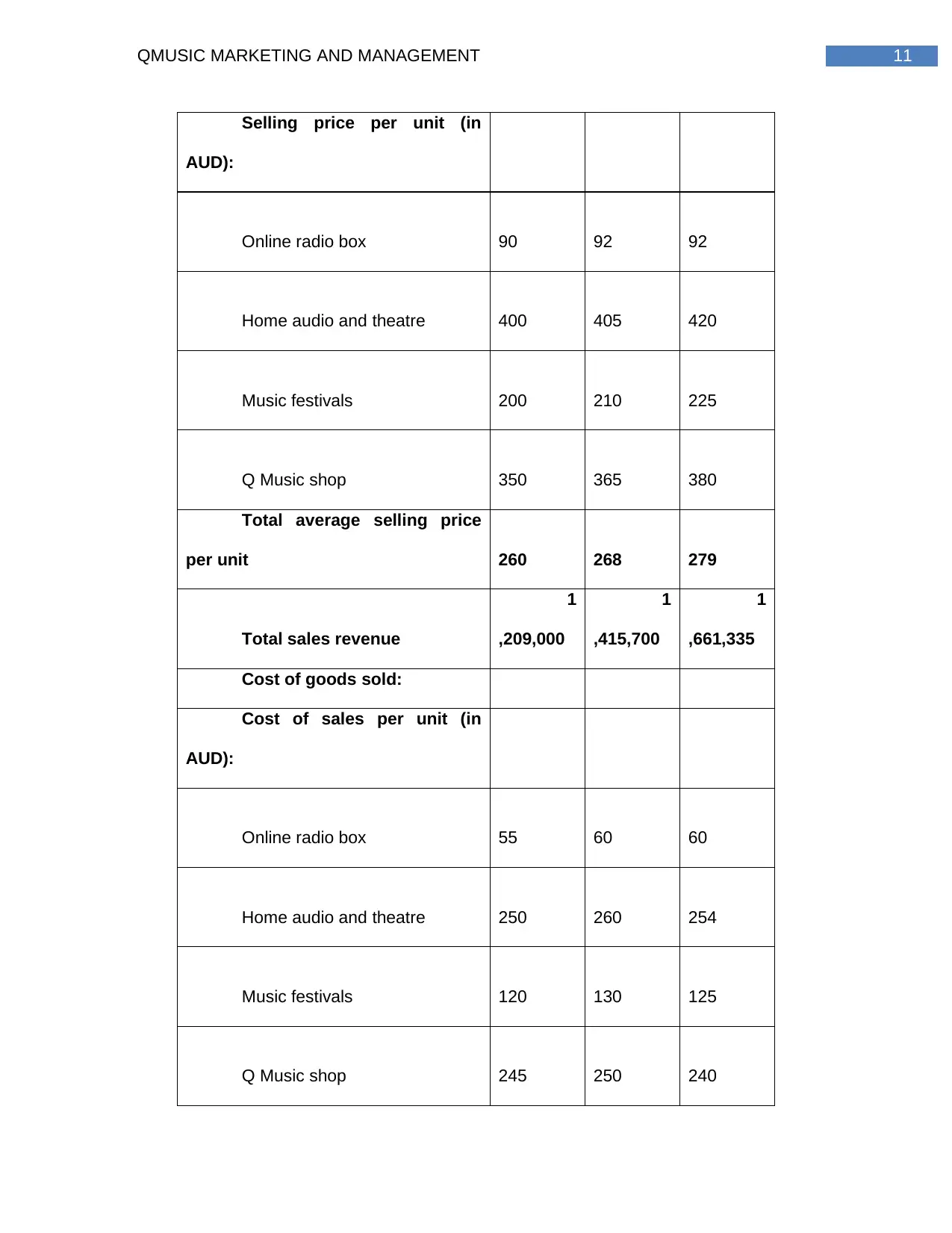
11QMUSIC MARKETING AND MANAGEMENT
Selling price per unit (in
AUD):
Online radio box 90 92 92
Home audio and theatre 400 405 420
Music festivals 200 210 225
Q Music shop 350 365 380
Total average selling price
per unit 260 268 279
Total sales revenue
1
,209,000
1
,415,700
1
,661,335
Cost of goods sold:
Cost of sales per unit (in
AUD):
Online radio box 55 60 60
Home audio and theatre 250 260 254
Music festivals 120 130 125
Q Music shop 245 250 240
Selling price per unit (in
AUD):
Online radio box 90 92 92
Home audio and theatre 400 405 420
Music festivals 200 210 225
Q Music shop 350 365 380
Total average selling price
per unit 260 268 279
Total sales revenue
1
,209,000
1
,415,700
1
,661,335
Cost of goods sold:
Cost of sales per unit (in
AUD):
Online radio box 55 60 60
Home audio and theatre 250 260 254
Music festivals 120 130 125
Q Music shop 245 250 240
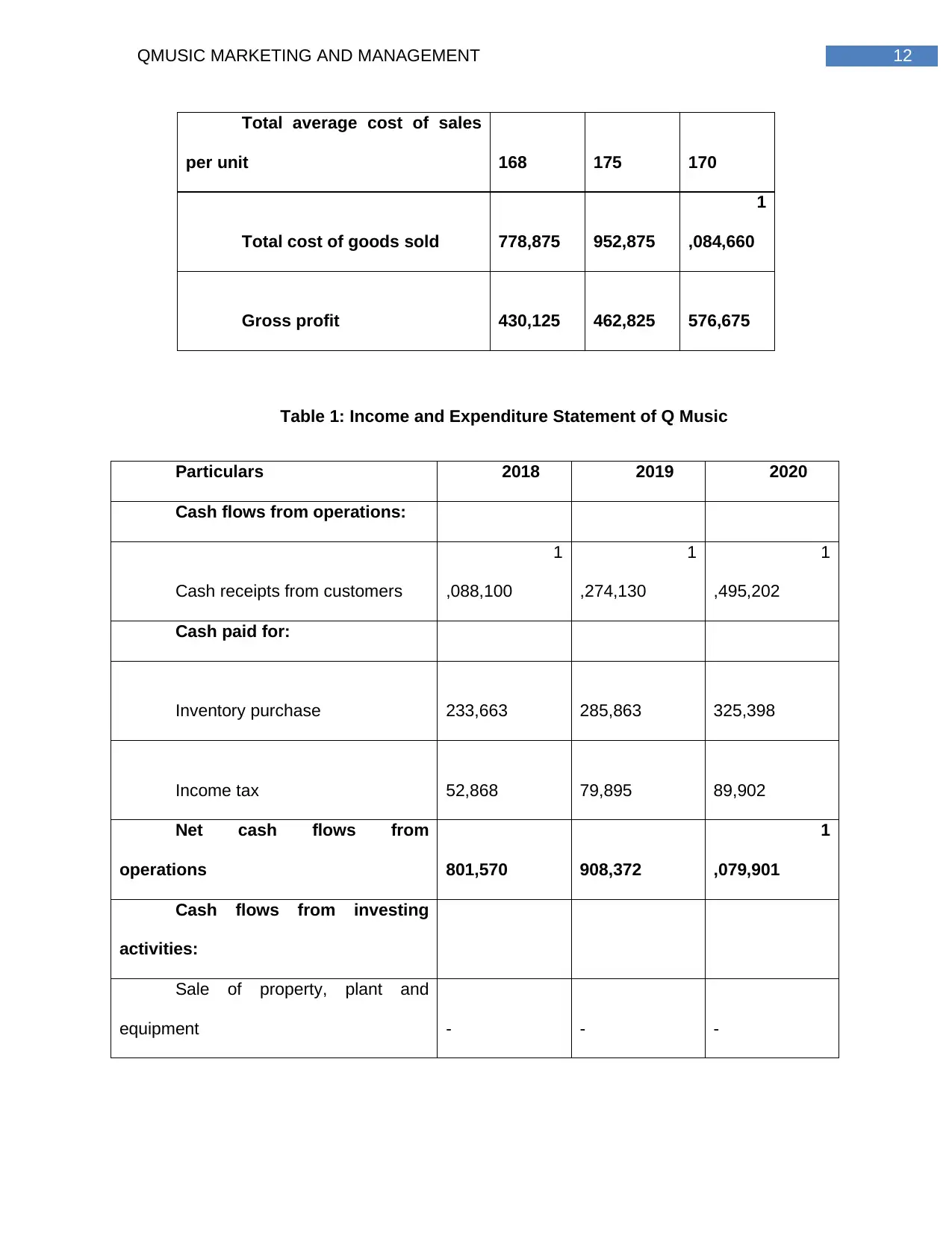
12QMUSIC MARKETING AND MANAGEMENT
Total average cost of sales
per unit 168 175 170
Total cost of goods sold 778,875 952,875
1
,084,660
Gross profit 430,125 462,825 576,675
Table 1: Income and Expenditure Statement of Q Music
Particulars 2018 2019 2020
Cash flows from operations:
Cash receipts from customers
1
,088,100
1
,274,130
1
,495,202
Cash paid for:
Inventory purchase 233,663 285,863 325,398
Income tax 52,868 79,895 89,902
Net cash flows from
operations 801,570 908,372
1
,079,901
Cash flows from investing
activities:
Sale of property, plant and
equipment - - -
Total average cost of sales
per unit 168 175 170
Total cost of goods sold 778,875 952,875
1
,084,660
Gross profit 430,125 462,825 576,675
Table 1: Income and Expenditure Statement of Q Music
Particulars 2018 2019 2020
Cash flows from operations:
Cash receipts from customers
1
,088,100
1
,274,130
1
,495,202
Cash paid for:
Inventory purchase 233,663 285,863 325,398
Income tax 52,868 79,895 89,902
Net cash flows from
operations 801,570 908,372
1
,079,901
Cash flows from investing
activities:
Sale of property, plant and
equipment - - -
Paraphrase This Document
Need a fresh take? Get an instant paraphrase of this document with our AI Paraphraser
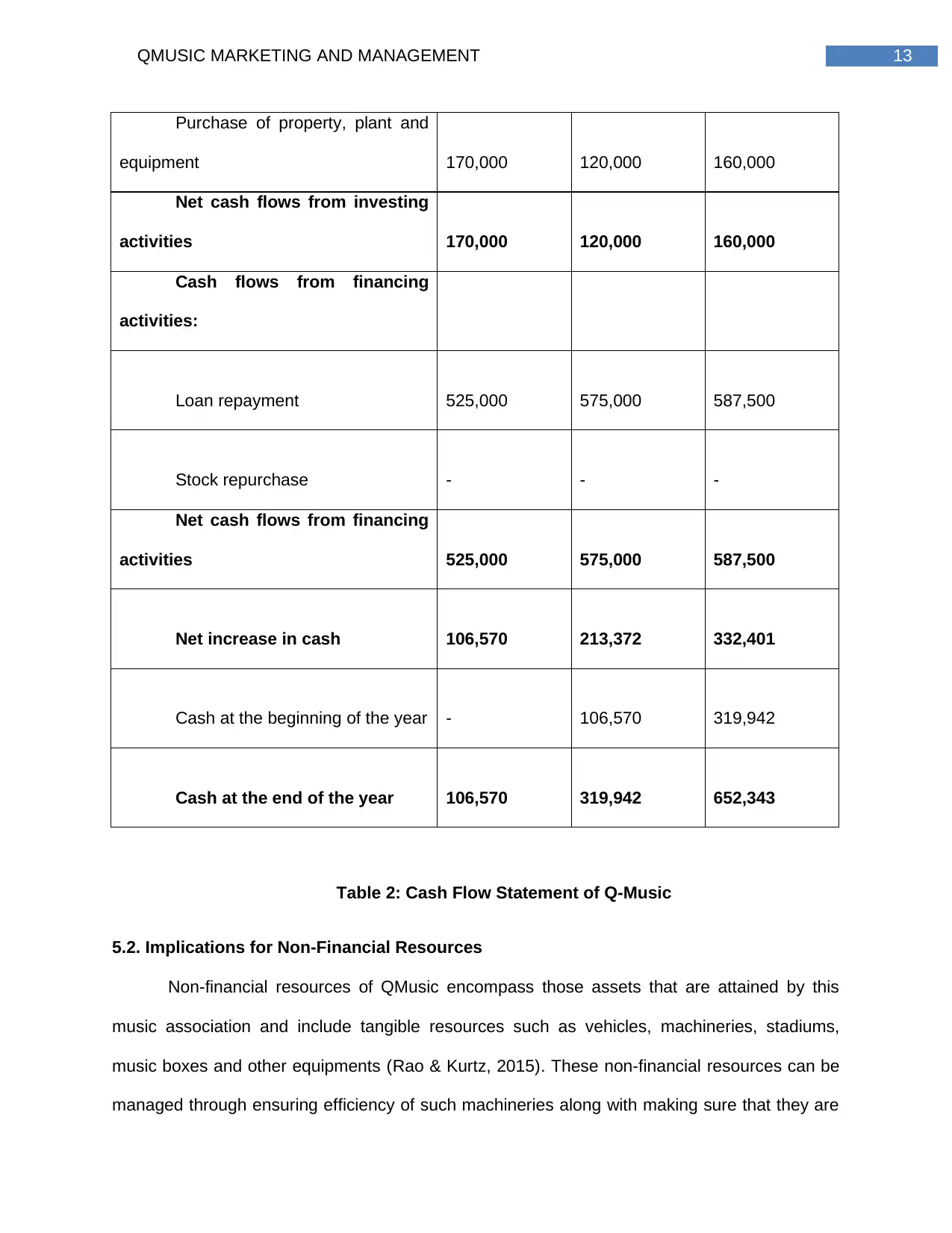
13QMUSIC MARKETING AND MANAGEMENT
Purchase of property, plant and
equipment 170,000 120,000 160,000
Net cash flows from investing
activities 170,000 120,000 160,000
Cash flows from financing
activities:
Loan repayment 525,000 575,000 587,500
Stock repurchase - - -
Net cash flows from financing
activities 525,000 575,000 587,500
Net increase in cash 106,570 213,372 332,401
Cash at the beginning of the year - 106,570 319,942
Cash at the end of the year 106,570 319,942 652,343
Table 2: Cash Flow Statement of Q-Music
5.2. Implications for Non-Financial Resources
Non-financial resources of QMusic encompass those assets that are attained by this
music association and include tangible resources such as vehicles, machineries, stadiums,
music boxes and other equipments (Rao & Kurtz, 2015). These non-financial resources can be
managed through ensuring efficiency of such machineries along with making sure that they are
Purchase of property, plant and
equipment 170,000 120,000 160,000
Net cash flows from investing
activities 170,000 120,000 160,000
Cash flows from financing
activities:
Loan repayment 525,000 575,000 587,500
Stock repurchase - - -
Net cash flows from financing
activities 525,000 575,000 587,500
Net increase in cash 106,570 213,372 332,401
Cash at the beginning of the year - 106,570 319,942
Cash at the end of the year 106,570 319,942 652,343
Table 2: Cash Flow Statement of Q-Music
5.2. Implications for Non-Financial Resources
Non-financial resources of QMusic encompass those assets that are attained by this
music association and include tangible resources such as vehicles, machineries, stadiums,
music boxes and other equipments (Rao & Kurtz, 2015). These non-financial resources can be
managed through ensuring efficiency of such machineries along with making sure that they are
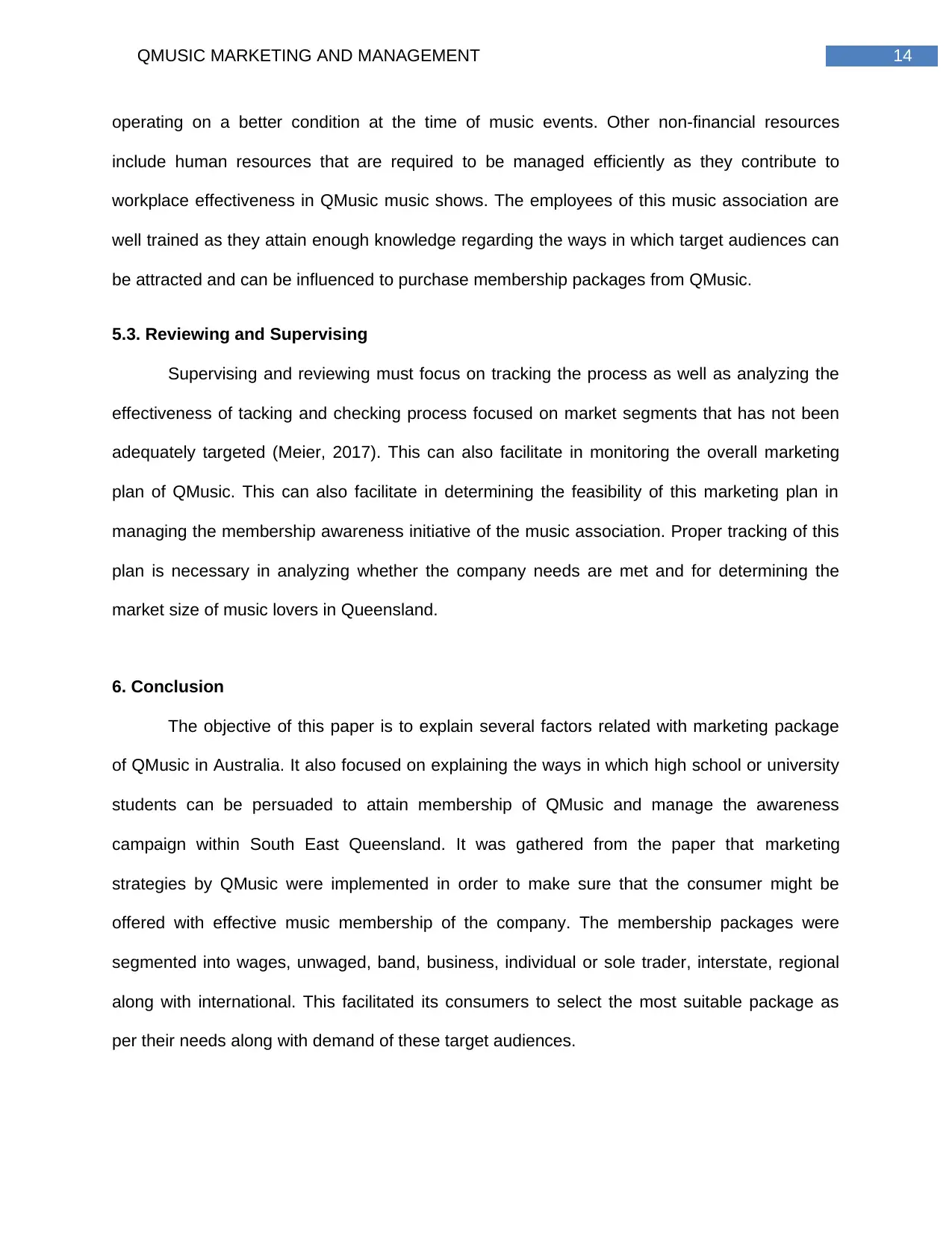
14QMUSIC MARKETING AND MANAGEMENT
operating on a better condition at the time of music events. Other non-financial resources
include human resources that are required to be managed efficiently as they contribute to
workplace effectiveness in QMusic music shows. The employees of this music association are
well trained as they attain enough knowledge regarding the ways in which target audiences can
be attracted and can be influenced to purchase membership packages from QMusic.
5.3. Reviewing and Supervising
Supervising and reviewing must focus on tracking the process as well as analyzing the
effectiveness of tacking and checking process focused on market segments that has not been
adequately targeted (Meier, 2017). This can also facilitate in monitoring the overall marketing
plan of QMusic. This can also facilitate in determining the feasibility of this marketing plan in
managing the membership awareness initiative of the music association. Proper tracking of this
plan is necessary in analyzing whether the company needs are met and for determining the
market size of music lovers in Queensland.
6. Conclusion
The objective of this paper is to explain several factors related with marketing package
of QMusic in Australia. It also focused on explaining the ways in which high school or university
students can be persuaded to attain membership of QMusic and manage the awareness
campaign within South East Queensland. It was gathered from the paper that marketing
strategies by QMusic were implemented in order to make sure that the consumer might be
offered with effective music membership of the company. The membership packages were
segmented into wages, unwaged, band, business, individual or sole trader, interstate, regional
along with international. This facilitated its consumers to select the most suitable package as
per their needs along with demand of these target audiences.
operating on a better condition at the time of music events. Other non-financial resources
include human resources that are required to be managed efficiently as they contribute to
workplace effectiveness in QMusic music shows. The employees of this music association are
well trained as they attain enough knowledge regarding the ways in which target audiences can
be attracted and can be influenced to purchase membership packages from QMusic.
5.3. Reviewing and Supervising
Supervising and reviewing must focus on tracking the process as well as analyzing the
effectiveness of tacking and checking process focused on market segments that has not been
adequately targeted (Meier, 2017). This can also facilitate in monitoring the overall marketing
plan of QMusic. This can also facilitate in determining the feasibility of this marketing plan in
managing the membership awareness initiative of the music association. Proper tracking of this
plan is necessary in analyzing whether the company needs are met and for determining the
market size of music lovers in Queensland.
6. Conclusion
The objective of this paper is to explain several factors related with marketing package
of QMusic in Australia. It also focused on explaining the ways in which high school or university
students can be persuaded to attain membership of QMusic and manage the awareness
campaign within South East Queensland. It was gathered from the paper that marketing
strategies by QMusic were implemented in order to make sure that the consumer might be
offered with effective music membership of the company. The membership packages were
segmented into wages, unwaged, band, business, individual or sole trader, interstate, regional
along with international. This facilitated its consumers to select the most suitable package as
per their needs along with demand of these target audiences.
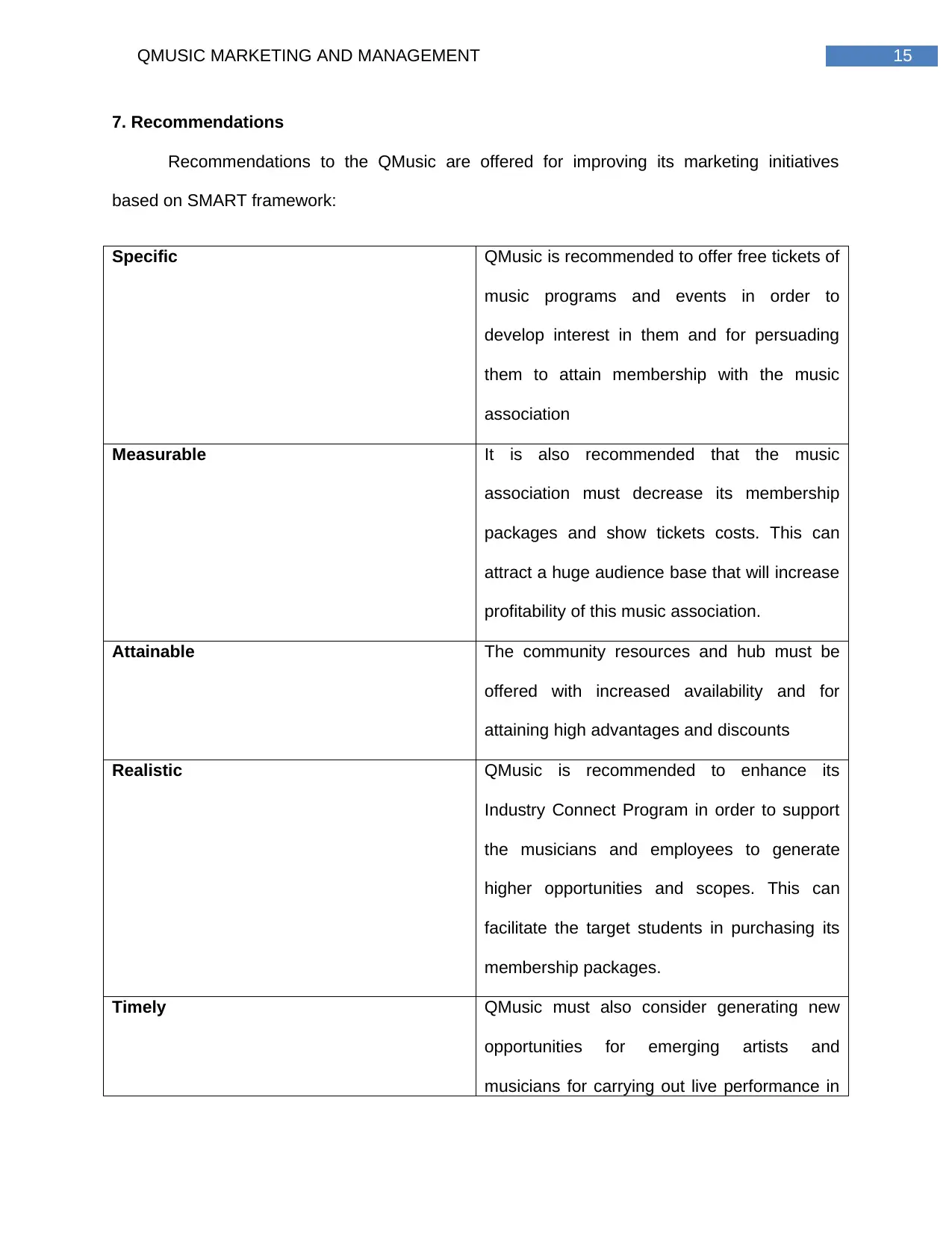
15QMUSIC MARKETING AND MANAGEMENT
7. Recommendations
Recommendations to the QMusic are offered for improving its marketing initiatives
based on SMART framework:
Specific QMusic is recommended to offer free tickets of
music programs and events in order to
develop interest in them and for persuading
them to attain membership with the music
association
Measurable It is also recommended that the music
association must decrease its membership
packages and show tickets costs. This can
attract a huge audience base that will increase
profitability of this music association.
Attainable The community resources and hub must be
offered with increased availability and for
attaining high advantages and discounts
Realistic QMusic is recommended to enhance its
Industry Connect Program in order to support
the musicians and employees to generate
higher opportunities and scopes. This can
facilitate the target students in purchasing its
membership packages.
Timely QMusic must also consider generating new
opportunities for emerging artists and
musicians for carrying out live performance in
7. Recommendations
Recommendations to the QMusic are offered for improving its marketing initiatives
based on SMART framework:
Specific QMusic is recommended to offer free tickets of
music programs and events in order to
develop interest in them and for persuading
them to attain membership with the music
association
Measurable It is also recommended that the music
association must decrease its membership
packages and show tickets costs. This can
attract a huge audience base that will increase
profitability of this music association.
Attainable The community resources and hub must be
offered with increased availability and for
attaining high advantages and discounts
Realistic QMusic is recommended to enhance its
Industry Connect Program in order to support
the musicians and employees to generate
higher opportunities and scopes. This can
facilitate the target students in purchasing its
membership packages.
Timely QMusic must also consider generating new
opportunities for emerging artists and
musicians for carrying out live performance in
Secure Best Marks with AI Grader
Need help grading? Try our AI Grader for instant feedback on your assignments.

16QMUSIC MARKETING AND MANAGEMENT
Big Sound in the upcoming year. This can
attract a huge consumer base for being its
membership packages.
Big Sound in the upcoming year. This can
attract a huge consumer base for being its
membership packages.
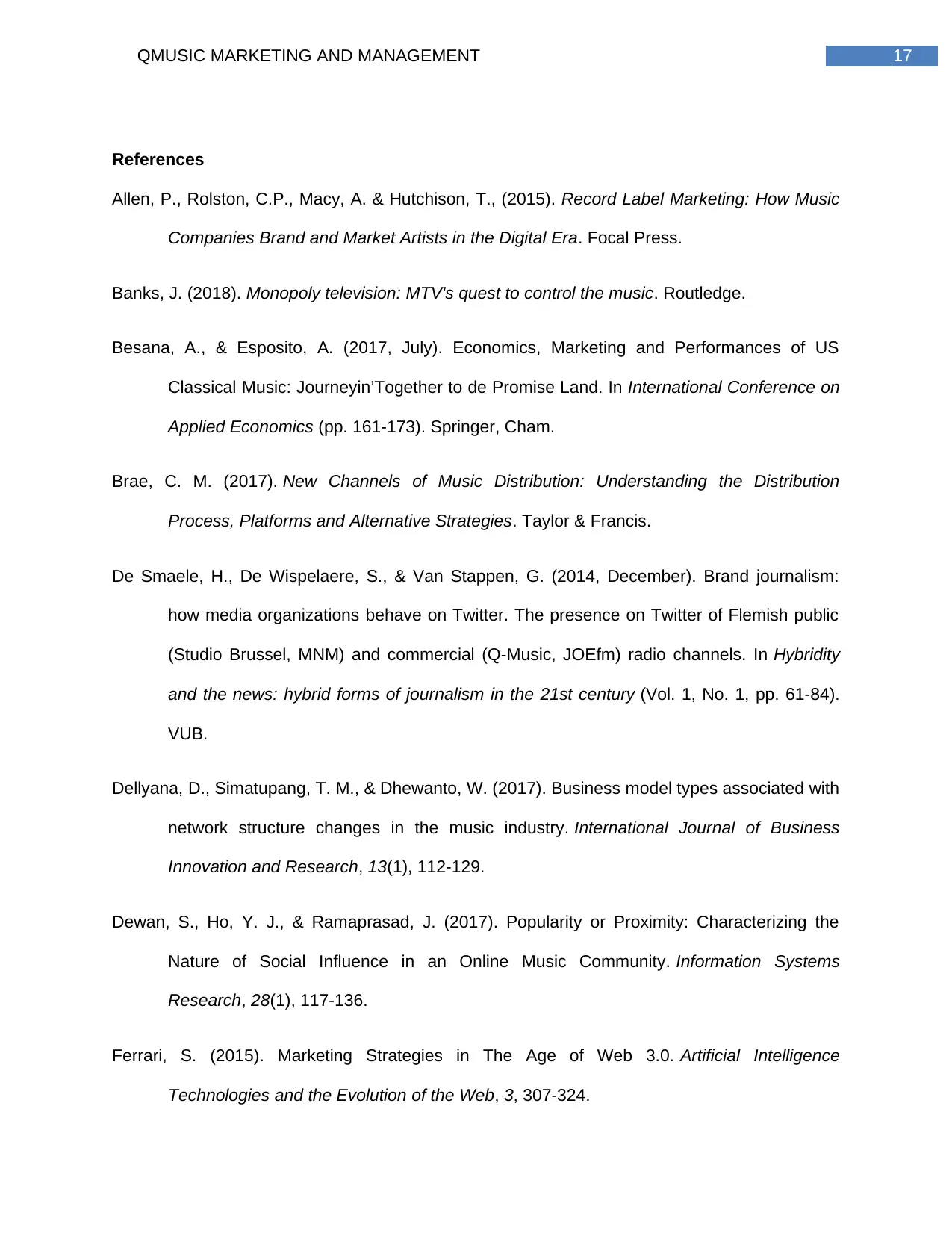
17QMUSIC MARKETING AND MANAGEMENT
References
Allen, P., Rolston, C.P., Macy, A. & Hutchison, T., (2015). Record Label Marketing: How Music
Companies Brand and Market Artists in the Digital Era. Focal Press.
Banks, J. (2018). Monopoly television: MTV's quest to control the music. Routledge.
Besana, A., & Esposito, A. (2017, July). Economics, Marketing and Performances of US
Classical Music: Journeyin’Together to de Promise Land. In International Conference on
Applied Economics (pp. 161-173). Springer, Cham.
Brae, C. M. (2017). New Channels of Music Distribution: Understanding the Distribution
Process, Platforms and Alternative Strategies. Taylor & Francis.
De Smaele, H., De Wispelaere, S., & Van Stappen, G. (2014, December). Brand journalism:
how media organizations behave on Twitter. The presence on Twitter of Flemish public
(Studio Brussel, MNM) and commercial (Q-Music, JOEfm) radio channels. In Hybridity
and the news: hybrid forms of journalism in the 21st century (Vol. 1, No. 1, pp. 61-84).
VUB.
Dellyana, D., Simatupang, T. M., & Dhewanto, W. (2017). Business model types associated with
network structure changes in the music industry. International Journal of Business
Innovation and Research, 13(1), 112-129.
Dewan, S., Ho, Y. J., & Ramaprasad, J. (2017). Popularity or Proximity: Characterizing the
Nature of Social Influence in an Online Music Community. Information Systems
Research, 28(1), 117-136.
Ferrari, S. (2015). Marketing Strategies in The Age of Web 3.0. Artificial Intelligence
Technologies and the Evolution of the Web, 3, 307-324.
References
Allen, P., Rolston, C.P., Macy, A. & Hutchison, T., (2015). Record Label Marketing: How Music
Companies Brand and Market Artists in the Digital Era. Focal Press.
Banks, J. (2018). Monopoly television: MTV's quest to control the music. Routledge.
Besana, A., & Esposito, A. (2017, July). Economics, Marketing and Performances of US
Classical Music: Journeyin’Together to de Promise Land. In International Conference on
Applied Economics (pp. 161-173). Springer, Cham.
Brae, C. M. (2017). New Channels of Music Distribution: Understanding the Distribution
Process, Platforms and Alternative Strategies. Taylor & Francis.
De Smaele, H., De Wispelaere, S., & Van Stappen, G. (2014, December). Brand journalism:
how media organizations behave on Twitter. The presence on Twitter of Flemish public
(Studio Brussel, MNM) and commercial (Q-Music, JOEfm) radio channels. In Hybridity
and the news: hybrid forms of journalism in the 21st century (Vol. 1, No. 1, pp. 61-84).
VUB.
Dellyana, D., Simatupang, T. M., & Dhewanto, W. (2017). Business model types associated with
network structure changes in the music industry. International Journal of Business
Innovation and Research, 13(1), 112-129.
Dewan, S., Ho, Y. J., & Ramaprasad, J. (2017). Popularity or Proximity: Characterizing the
Nature of Social Influence in an Online Music Community. Information Systems
Research, 28(1), 117-136.
Ferrari, S. (2015). Marketing Strategies in The Age of Web 3.0. Artificial Intelligence
Technologies and the Evolution of the Web, 3, 307-324.
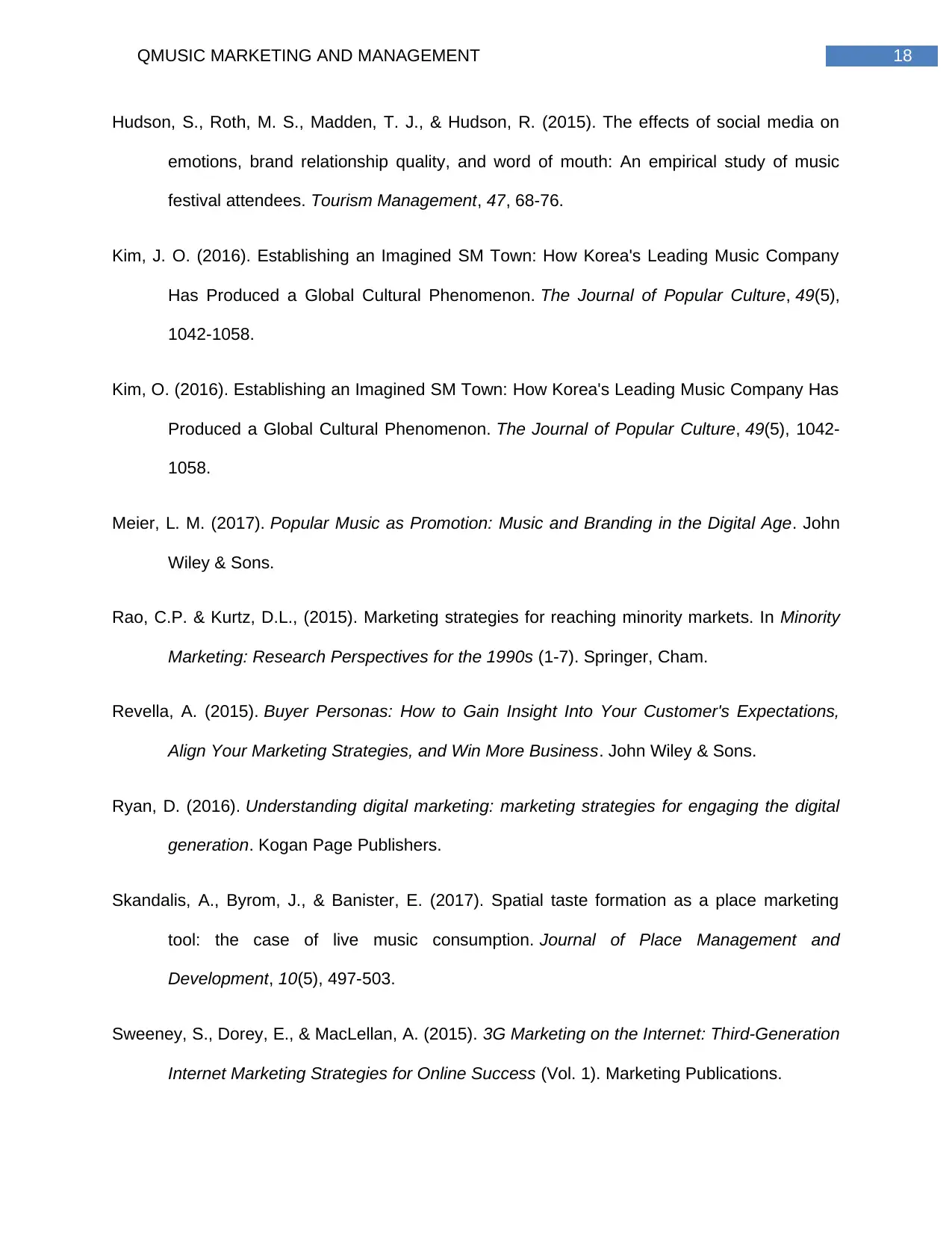
18QMUSIC MARKETING AND MANAGEMENT
Hudson, S., Roth, M. S., Madden, T. J., & Hudson, R. (2015). The effects of social media on
emotions, brand relationship quality, and word of mouth: An empirical study of music
festival attendees. Tourism Management, 47, 68-76.
Kim, J. O. (2016). Establishing an Imagined SM Town: How Korea's Leading Music Company
Has Produced a Global Cultural Phenomenon. The Journal of Popular Culture, 49(5),
1042-1058.
Kim, O. (2016). Establishing an Imagined SM Town: How Korea's Leading Music Company Has
Produced a Global Cultural Phenomenon. The Journal of Popular Culture, 49(5), 1042-
1058.
Meier, L. M. (2017). Popular Music as Promotion: Music and Branding in the Digital Age. John
Wiley & Sons.
Rao, C.P. & Kurtz, D.L., (2015). Marketing strategies for reaching minority markets. In Minority
Marketing: Research Perspectives for the 1990s (1-7). Springer, Cham.
Revella, A. (2015). Buyer Personas: How to Gain Insight Into Your Customer's Expectations,
Align Your Marketing Strategies, and Win More Business. John Wiley & Sons.
Ryan, D. (2016). Understanding digital marketing: marketing strategies for engaging the digital
generation. Kogan Page Publishers.
Skandalis, A., Byrom, J., & Banister, E. (2017). Spatial taste formation as a place marketing
tool: the case of live music consumption. Journal of Place Management and
Development, 10(5), 497-503.
Sweeney, S., Dorey, E., & MacLellan, A. (2015). 3G Marketing on the Internet: Third-Generation
Internet Marketing Strategies for Online Success (Vol. 1). Marketing Publications.
Hudson, S., Roth, M. S., Madden, T. J., & Hudson, R. (2015). The effects of social media on
emotions, brand relationship quality, and word of mouth: An empirical study of music
festival attendees. Tourism Management, 47, 68-76.
Kim, J. O. (2016). Establishing an Imagined SM Town: How Korea's Leading Music Company
Has Produced a Global Cultural Phenomenon. The Journal of Popular Culture, 49(5),
1042-1058.
Kim, O. (2016). Establishing an Imagined SM Town: How Korea's Leading Music Company Has
Produced a Global Cultural Phenomenon. The Journal of Popular Culture, 49(5), 1042-
1058.
Meier, L. M. (2017). Popular Music as Promotion: Music and Branding in the Digital Age. John
Wiley & Sons.
Rao, C.P. & Kurtz, D.L., (2015). Marketing strategies for reaching minority markets. In Minority
Marketing: Research Perspectives for the 1990s (1-7). Springer, Cham.
Revella, A. (2015). Buyer Personas: How to Gain Insight Into Your Customer's Expectations,
Align Your Marketing Strategies, and Win More Business. John Wiley & Sons.
Ryan, D. (2016). Understanding digital marketing: marketing strategies for engaging the digital
generation. Kogan Page Publishers.
Skandalis, A., Byrom, J., & Banister, E. (2017). Spatial taste formation as a place marketing
tool: the case of live music consumption. Journal of Place Management and
Development, 10(5), 497-503.
Sweeney, S., Dorey, E., & MacLellan, A. (2015). 3G Marketing on the Internet: Third-Generation
Internet Marketing Strategies for Online Success (Vol. 1). Marketing Publications.
1 out of 19
Related Documents
Your All-in-One AI-Powered Toolkit for Academic Success.
+13062052269
info@desklib.com
Available 24*7 on WhatsApp / Email
![[object Object]](/_next/static/media/star-bottom.7253800d.svg)
Unlock your academic potential
© 2024 | Zucol Services PVT LTD | All rights reserved.





